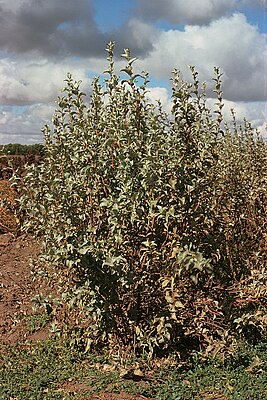Silver olive willow
| Silver olive willow | ||||||||||||
|---|---|---|---|---|---|---|---|---|---|---|---|---|

Silver olive willow ( Elaeagnus commutata ) |
||||||||||||
| Systematics | ||||||||||||
|
||||||||||||
| Scientific name | ||||||||||||
| Elaeagnus commutata | ||||||||||||
| Bernh. ex Rydb. |
The silver olive ( Elaeagnus commutata ) is a species of the olive family (Elaeagnaceae). This species, which comes from North America , is used as an ornamental shrub in Central Europe and is wild in some places.
description
The silver olive willow is a deciduous shrub that reaches heights of 1 to 4 meters. It forms strong rhizomes . The bark of the branches is silvery to reddish brown, that of the older branches is dark grayish red, that of the young branches is brown or green. The alternate leaves are short stalked. The leaf blade is at a length of 2-7 cm and a width of up to 4.5 centimeters lanceolate to reversed-lanceolate both sides silvery with wavy margin.
The flowering period extends from March to May. One to three short-stalked flowers that are bent downwards sit on an axillary inflorescence . The fragrant flowers are four-fold. The four petals are fused together like a funnel. The corolla tube is yellow inside and silvery outside and ends with four corolla lobes. There are four stamens .
The achenes are encased in an egg-shaped, silvery, floury “berry” that is 9 to 12 millimeters long.
The number of chromosomes is 2n = 28.
distribution
The home of the silver olive willow stretches across large parts of North America. The occurrences extend from southern Alaska as well as the Yukon Territory and British Columbia in Canada east to Ontario and Quebec ; to the south the distribution area extends into the US states of Idaho , Montana , Wyoming , Utah , Minnesota , North Dakota and South Dakota .
Systematics
The description, which goes back to the German botanist Johann Jakob Bernhardi (1774–1850), was published in 1917 by the American botanist Per Axel Rydberg . A synonym is Elaeagnus argentea Pursh .
use
The cultivar 'Zempin' with partly differently spotted leaves is used as an ornamental wood.
Black-footed Indians used the silver oil willow as food and medicine . The fruits were eaten fresh or cooked in soups . Solid ropes were made from the bark and soap was made from the fruit. A decoction made from the bark mixed with fat is used for frostbite.
The fruits and seeds are eaten raw or cooked and are dry and floury. The fruit must be fully ripe before it tastes raw, before it is astringent . Medical effects were examined.
Individual evidence
- ^ Erich Oberdorfer : Plant-sociological excursion flora for Germany and neighboring areas. 8th edition. Verlag Eugen Ulmer, Stuttgart 2001, ISBN 3-8001-3131-5 . Page 662.
- ↑ Elaeagnus commutata in the Germplasm Resources Information Network (GRIN), USDA , ARS , National Genetic Resources Program. National Germplasm Resources Laboratory, Beltsville, Maryland.
- ↑ Fl. Rocky Mts. 582. 1917.
- ^ Kathy Lloyd: American Silverberry in Montana Native Plant Society .
- ↑ Elaeagnus commutata in Plants For A Future
Web links
- Data Sheet for E-Flora BC: Electronic Atlas of the Plants of British Columbia (Engl.)
- Siegmund Seybold : Flora of Germany and neighboring countries. A book for identifying vascular plants that grow wild and often cultivated . Founded by Otto Schmeil , Jost Fitschen . 93rd completely revised and expanded edition. Quelle & Meyer, Wiebelsheim 2006, ISBN 3-494-01413-2 .
- Silver olive willow . In: BiolFlor, the database of biological-ecological characteristics of the flora of Germany.
- Elaeagnus commutata Rydb., Silver olive willow. In: FloraWeb.de.
- Thomas Meyer: Data sheet with identification key and photos at Flora-de: Flora von Deutschland (old name of the website: Flowers in Swabia )
